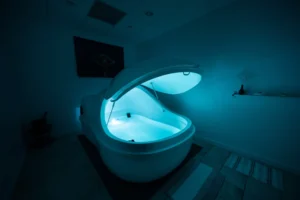In our fast-paced world, people constantly look for new ways to relax, recharge, and relieve stress. Traditional relaxation techniques such as meditation, yoga, and massages are valuable, but many individuals are discovering something even more transformative Float Therapy. The Benefits of Float Therapy are extensive, addressing both the body and mind in ways that go far beyond ordinary relaxation.
This article explores Float Session Therapy, explains Float Therapy What Is It, breaks down the Science Behind Float Therapy, and highlights the Float Tank Therapy Benefits that make it a standout method for modern stress relief.
Float Therapy – What Is It?
So, what exactly is Float Therapy? Imagine lying effortlessly in a tank filled with warm water and Epsom salt. The salt creates buoyancy so you float without effort, while the water matches your skin temperature. The tank is designed to be dark and soundproof, eliminating external distractions. This is Sensory Deprivation Float Therapy, also known as an Isolation Tank Therapy experience.
A Float Therapy Session typically lasts about 60 minutes, during which the brain shifts into a meditative state. The experience creates conditions for deep mental rest and physical rejuvenation, leading to the many Float Session Benefits people report after their first few sessions.
The Science Behind Float Therapy
The Science Behind Float Therapy lies in how the brain and body respond to the lack of external stimuli. In our daily lives, our senses are bombarded with noise, light, and physical tension. During Sensory Deprivation Float Therapy, the brain gets a chance to reset.
The purpose of a sensory deprivation tank is to remove external stimulation so your nervous system can shift from “fight or flight” into “rest and digest.” This transition lowers cortisol levels, eases tension, and allows your body to recover more efficiently.
The buoyancy of the saltwater also relieves pressure on joints and muscles, which explains some of the remarkable Float Deprivation Tank Benefits. Floating supports muscle recovery, improves circulation, and may even enhance magnesium absorption through the skin.
Health Benefits of Float Therapy
There are numerous Health Benefits of Float Therapy, which extend across physical, emotional, and mental wellness. Here are some key ways Float Session Therapy contributes to holistic health:
- Deep Muscle Relaxation:
The buoyant environment takes pressure off the body, providing the same relief as zero gravity. This helps reduce chronic pain and tension. - Improved Sleep Quality:
Many people use Float Therapy for Relaxation to combat insomnia. After a Float Therapy Session, the body’s nervous system is calmer, helping achieve deep, uninterrupted sleep. - Stress and Anxiety Relief:
The sensory isolation effect has a direct impact on stress hormones. Those experiencing Float Tank Anxiety or mental fatigue often find the experience grounding and peaceful. - Enhanced Mental Clarity:
Floating promotes alpha and theta brainwave activity states linked to creativity, focus, and problem-solving. - Mood Enhancement and Emotional Balance:
Regular float sessions can increase dopamine and serotonin, helping with Float Therapy for Depression and general mood regulation.
The Health Benefits of Float Therapy are both immediate and long-term. Over time, consistent floating can improve resilience to stress and foster emotional stability.
The Benefits of Float Therapy vs. Traditional Relaxation Methods
When comparing Float Tank Therapy Benefits to traditional relaxation techniques, several differences stand out:
| Traditional Methods | Float Therapy |
| Relies on external stimulation (music, touch, temperature) | Removes external stimulation for total sensory rest |
| Temporary relaxation of muscles | Deep neuromuscular and psychological relaxation |
| Mind often remains active | Mind enters meditative or dream-like state |
| Gravity still impacts body | Buoyancy eliminates pressure on spine and joints |
| Benefits fade quickly | Repeated floats provide cumulative results |
Traditional relaxation techniques like massages or meditation are excellent, but they don’t create complete sensory isolation. Float Session Therapy allows you to experience the kind of stillness that most people never achieve in daily life.
Float Therapy for Depression and Anxiety
Among the most discussed Effects of Float Therapy are its emotional and psychological impacts. In recent years, researchers have explored Float Therapy for Depression and Float Tank Anxiety relief with encouraging results.
By reducing sensory input, floating reduces overactivity in the parts of the brain responsible for fear and stress. This promotes a feeling of calm and safety. Regular float sessions can reduce symptoms of anxiety, stabilize mood, and even support other forms of therapy.
People suffering from burnout or emotional exhaustion often find that the Benefits of Sensory Deprivation Float Tanks include profound mental rest. The quiet, weightless environment encourages introspection, allowing the mind to declutter and the body to heal.
The Physical Benefits of Float Therapy
While mental health improvements are powerful, the physical Float Tank Therapy Benefits are equally remarkable.
- Pain Relief: Floating relieves pressure from joints, muscles, and the spine.
- Improved Circulation: With reduced body pressure, blood flow increases.
- Faster Recovery: Athletes use Float Session Therapy to recover after workouts or injuries.
- Detoxification: The magnesium sulfate in the saltwater supports muscle function and helps the body remove toxins.
The Health Benefits of Float Therapy make it appealing to people with chronic pain, arthritis, or postural problems. Floating is a safe, low-impact therapy suitable for people of all ages.
The Psychological Effects of Float Therapy
The Effects of Float Therapy on the brain are fascinating. Inside a float tank, your brain waves slow down to the same state achieved by advanced meditation practitioners.
This deep state of rest can bring mental clarity, creativity, and problem-solving insights. Many writers, artists, and entrepreneurs use Float Session Therapy to unlock creativity or overcome burnout.
Additionally, the Benefits of Float Therapy extend into mindfulness because there are no distractions, you’re more aware of thoughts, emotions, and physical sensations. This heightened awareness carries over into daily life, promoting calmness and focus.
Purpose of Sensory Deprivation Tank Sessions
The Purpose of a Sensory Deprivation Tank is to provide complete rest to the nervous system. The human body is constantly reacting to stimuli, sound, gravity, light, and touch. By removing those inputs, Sensory Deprivation Float Therapy creates conditions where true healing and relaxation can occur.
This state allows your body to conserve energy, your brain to recharge, and your hormones to balance. This is why the Benefits of Floatation Tanks are so distinct from other wellness methods.
Float Therapy for Relaxation
If you’re simply seeking peace and rest, Float Therapy for Relaxation offers a unique escape from daily overstimulation. During a Float Therapy Session, you drift in total silence, detached from your usual environment.
Unlike typical relaxation methods, floating provides instant weightlessness your muscles and joints stop working against gravity. Many people describe it as being “suspended in nothingness,” a sensation that delivers profound calmness and rejuvenation.
Because the Float Session Benefits combine physical, emotional, and mental relaxation, many find that an hour in a tank equals several hours of quality sleep or meditation.
Who Can Benefit from Float Therapy?
The Benefits of Floatation Tanks extend to nearly everyone. Here’s who might find it particularly helpful:
- Individuals with chronic stress or anxiety
- Those experiencing mild depression or burnout
- Athletes or fitness enthusiasts seeking muscle recovery
- Professionals dealing with mental fatigue
- Anyone looking to deepen meditation or mindfulness practices
The Float Deprivation Tank Benefits make it suitable for people from all walks of life. Whether you’re healing from physical exertion or simply need to disconnect from the noise of modern living, floating provides a holistic path toward wellness.
What to Expect During a Float Therapy Session
If it’s your first time trying Float Session Therapy, here’s what typically happens:
- You shower before entering the tank.
- You step into the warm, salty water.
- Once you settle, you close the lid or door.
- The lights go out, and the sound disappears.
- You float effortlessly in complete silence.
For the next 60 minutes, you experience pure calm. Some people meditate, others simply rest. Afterward, you shower again to remove the salt.
Many describe feeling reborn as the Float Tank Therapy Benefits include deep relaxation, clarity, and renewed energy. With regular use, the Benefits of Float Therapy compound, helping manage stress and support mental balance.
Safety and Considerations
Float Session Therapy is generally safe for most people. However, those with open wounds, severe skin conditions, or epilepsy should consult a doctor first.
Claustrophobic individuals can keep the lid open or request a partially lit tank to ease into the experience. Proper hygiene and well-maintained facilities ensure a comfortable and clean session.
FAQs
Q1: What is Float Therapy?
A: Float Therapy is a relaxation practice where you float in saltwater inside a sensory deprivation tank. The environment removes external stimuli, promoting deep mental and physical relaxation.
Q2: How often should I do Float Session Therapy?
A: Beginners can start once a month, but weekly sessions provide stronger cumulative Float Session Benefits and deeper Health Benefits of Float Therapy.
Q3: Is Float Therapy good for depression and anxiety?
A: Yes. Float Therapy for Depression and Float Tank Anxiety relief are well-documented benefits, as floating helps balance mood and lower stress hormones.
Q4: Can Float Therapy replace meditation or massage?
A: Not replace — but enhance. The Benefits of Floatation Tanks combine the mindfulness of meditation with the physical relief of a massage.
Q5: What are the main Benefits of Float Therapy?
A: They include muscle relaxation, stress relief, improved sleep, better focus, mood balance, and overall nervous system recovery.
Q6: Are there any risks?
A: Minimal, when done correctly. Always choose a reputable center and consult your doctor if you have health concerns.
Final Thoughts
Traditional relaxation practices are valuable, but Float Session Therapy takes the experience to a new dimension. The Benefits of Float Therapy are profound from mental clarity and physical rejuvenation to emotional balance and creative insight.
The Science Behind Float Therapy supports its effectiveness, showing that sensory isolation helps reset both brain and body. Whether you seek Float Therapy for Relaxation, Float Therapy for Depression, or to overcome Float Tank Anxiety, the experience offers complete renewal.
Ultimately, the Benefits of Floatation Tanks prove that sometimes, doing absolutely nothing in silence, darkness, and weightlessness is the most powerful therapy of all.





